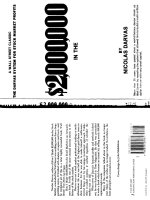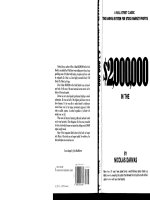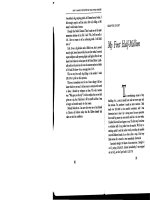Stop and make money; how to profit in the stock market using volume and stop orders
Bạn đang xem bản rút gọn của tài liệu. Xem và tải ngay bản đầy đủ của tài liệu tại đây (9.21 MB, 209 trang )
FM
JWPR057-Arms
October 18, 2007
13:48
Char Count=
Stop and Make
Money
How to Profit in the Stock Market
Using Volume and Stop Orders
RICHARD W. ARMS, JR.
FM
JWPR057-Arms
October 18, 2007
13:48
Char Count=
FM
JWPR057-Arms
October 18, 2007
13:48
Char Count=
Stop and Make
Money
FM
JWPR057-Arms
October 18, 2007
13:48
Char Count=
Founded in 1807, John Wiley & Sons is the oldest independent publishing company in the
United States. With offices in North America, Europe, Australia, and Asia, Wiley is globally committed to developing and marketing print and electronic products and services
for our customers’ professional and personal knowledge and understanding.
The Wiley Trading series features books by traders who have survived the market’s ever changing temperament and have prospered—some by reinventing systems,
others by getting back to basics. Whether a novice trader, professional, or somewhere
in-between, these books will provide the advice and strategies needed to prosper today
and well into the future.
For a list of available titles, please visit our Web site at www.WileyFinance.com.
FM
JWPR057-Arms
October 18, 2007
13:48
Char Count=
Stop and Make
Money
How to Profit in the Stock Market
Using Volume and Stop Orders
RICHARD W. ARMS, JR.
FM
JWPR057-Arms
October 18, 2007
13:48
Char Count=
Copyright c 2008 by Richard W. Arms, Jr. All rights reserved.
Published by John Wiley & Sons, Inc., Hoboken, New Jersey.
Published simultaneously in Canada.
Wiley Bicentennial Logo: Richard J. Pacifico
No part of this publication may be reproduced, stored in a retrieval system, or transmitted in any form or by
any means, electronic, mechanical, photocopying, recording, scanning, or otherwise, except as permitted under
Section 107 or 108 of the 1976 United States Copyright Act, without either the prior written permission of the
Publisher, or authorization through payment of the appropriate per-copy fee to the Copyright Clearance Center,
Inc., 222 Rosewood Drive, Danvers, MA 01923, (978) 750-8400, fax (978) 646-8600, or on the Web at
www.copyright.com. Requests to the Publisher for permission should be addressed to the Permissions
Department, John Wiley & Sons, Inc., 111 River Street, Hoboken, NJ 07030, (201) 748-6011, fax (201) 748-6008,
or online at />Limit of Liability/Disclaimer of Warranty: While the publisher and author have used their best efforts in
preparing this book, they make no representations or warranties with respect to the accuracy or completeness
of the contents of this book and specifically disclaim any implied warranties of merchantability or fitness for a
particular purpose. No warranty may be created or extended by sales representatives or written sales materials.
The advice and strategies contained herein may not be suitable for your situation. You should consult with a
professional where appropriate. Neither the publisher nor author shall be liable for any loss of profit or any
other commercial damages, including but not limited to special, incidental, consequential, or other damages.
For general information on our other products and services or for technical support, please contact our
Customer Care Department within the United States at (800) 762-2974, outside the United States at (317)
572-3993 or fax (317) 572-4002.
Designations used by companies to distinguish their products are often claimed as trademarks. In all instances
where John Wiley & Sons, Inc. is aware of a claim, the product names appear in initial capital or all capital
letters. Readers, however, should contact the appropriate companies for more complete information regarding
trademarks and registration.
Wiley also publishes its books in a variety of electronic formats. Some content that appears in print may not be
available in electronic formats. For more information about Wiley products, visit our Web site at
www.wiley.com.
MetaStock charts courtesy of Equis International, a Reuters company. All rights reserved.
Library of Congress Cataloging-in-Publication Data:
Arms, Richard W., 1935–
Stop and make money : how to profit in the stock market using volume and stop orders / Richard W. Arms, Jr.
p. cm. – (Wiley trading series)
Includes index.
ISBN 978-0-470-12996-8 (cloth/cd-rom)
1. Stocks–Charts, diagrams, etc. 2. Stock price forecasting. 3. Investment analysis. I. Title.
HG4916.A715 2008
332.63 2042–dc22
2007025163
Printed in the United States of America.
10 9 8 7 6 5 4 3 2 1
FM
JWPR057-Arms
October 18, 2007
13:48
Char Count=
For June: wife, companion, and best friend for half a century, so far.
FM
JWPR057-Arms
October 18, 2007
13:48
Char Count=
FM
JWPR057-Arms
October 18, 2007
13:48
Char Count=
Contents
Acknowledgments
ix
About the Author
xi
INTRODUCTION The Great Opportunity
1
CHAPTER 1
Let’s Get Started
7
CHAPTER 2
A Pair of Shorts
19
CHAPTER 3
Why Technical Analysis?
27
CHAPTER 4
The Market Is Always Right
33
CHAPTER 5
Equivolume Charts
39
CHAPTER 6
Getting Ready to Trade
47
CHAPTER 7
Choosing Your Route
53
CHAPTER 8
Power Boxes
67
CHAPTER 9
Okay, Let’s Buy
77
CHAPTER 10
Stop Orders for Getting In
87
CHAPTER 11
Stop Orders for Getting Out
95
CHAPTER 12
A Play, Not a Position
103
CHAPTER 13
Minding the Gaps
109
CHAPTER 14
Tops and Bottoms
115
CHAPTER 15
Flags, Pennants, and Rectangles
121
CHAPTER 16
Support and Resistance
133
vii
FM
JWPR057-Arms
October 18, 2007
13:48
Char Count=
viii
CONTENTS
CHAPTER 17
Trends and Channels
139
CHAPTER 18
Targets
145
CHAPTER 19
Ease of Movement and Volume-Adjusted
Moving Averages
151
CHAPTER 20
Is the Market Going to Go Up or Down?
159
CHAPTER 21
The Arms Index
165
CHAPTER 22
Market Tops and Bottoms
173
CHAPTER 23
In Conclusion
179
About the CD-ROM
183
Index
187
FM
JWPR057-Arms
October 18, 2007
13:48
Char Count=
Acknowledgments
y thanks to Betty Annis, who spent many hours reading the manuscript and detecting my prolific errors. Thanks to Paul Butt, for his long and detailed memories of how the markets used to be, way back when we were rookie brokers.
Charlie Kirkpatrick, author and expert on technical analysis, was extremely helpful in listening to my ideas and lending professional expertise. Stock search methods and ideas
were greatly assisted by Charles Brauer and his superb ability to create unique computer
programs. My thanks to my editors, Kevin Commins and Emilie Herman at John Wiley &
Sons, for the many ideas and subsequent debates over titles and format. But foremost is
my appreciation for the understanding of my friends and family, and especially June, for
tiptoeing past my office door as I put this book together.
M
ix
FM
JWPR057-Arms
October 18, 2007
13:48
Char Count=
FM
JWPR057-Arms
October 18, 2007
13:48
Char Count=
About the Author
ichard W. Arms, Jr. is one of the world’s most respected stock market personalities. Since 1996, he has been advising a select group of money managers and
financial institutions in the United States, Europe, and Canada. In addition, he
writes a twice-weekly Internet column for RealMoney, the institutional service from
TheStreet.com.
Mr. Arms invented and then popularized the Arms Index. This indicator, often called
TRIN, has become a mainstay of market analysis. It appears daily in the Wall Street
Journal and weekly in Barron’s. His index crosses the CNBC tape as “ARMS” every few
minutes throughout every trading day. He developed Equivolume charting, which has become a popular method featured on MetaStock and many other technical software packages. He is the inventor of Ease of Movement, volume cyclicality, and volume-adjusted
moving averages.
His books (Profits in Volume, Volume Cycles in the Stock Market, The Arms Index,
and Trading without Fear) have been translated into a number of languages, and his
methodology is familiar to most stock market traders and professionals in every financial
center. He was the 1995 recipient of the Market Technicians Association Outstanding
Contribution Award for his lifetime contribution to technical analysis.
R
xi
JWPR057-Ind
JWPR057-Arms
October 18, 2007
13:9
Char Count=
Index
5-day Moving average of Arms Index (AI), 168
10-day Moving average of Arms Index (AI),
170
13-day Ease of Movement Indicator, 152
13-day Weighted moving averages, 156
21-day Moving average of Arms Index (AI),
171
34-day Weighted moving averages, 156
for short term trading, 169
Trading Index (TRIN), 38
The Arms Index (Arms), 167
Ascending trend line, 116
Asimov, Isaac, 29
Autozone:
chart of, 68, 69
example of, 67
Abbott Labs, 84, 85
Abercrombie & Fitch, 126–127
Accumulations, 146
widths of, 147
zones of, 12
Active Power, 89
Advances end of, 125
Advance width vs. base widths, 146
Advisory letters, 48
Amazon, 125–126
Anadarko Petroleum:
daily chart of, 57
example of, 90
power boxes of, 91
weekly chart of, 57
Analytical tools, 13
Annotated Equivolume chart, 12
Anthropomorphism, 33
Anticipation, 36–37
Aquantive, 74
Arms Index (AI), 38, 165–171
calculation of, 166–167
example of, 167
making the charts more meaningful,
169–171
Bar charts:
gaps on, 110
of General Motors, 9
typical, 40
Barron’s, 48, 166
Base width of, 12
Base widths vs. advance width, 146
Baxter International, 80–81
Bear market, 167
Blockbuster, 37
Boeing:
chart of, 128
countertrend moves in, 63
example of, 44, 104–106
plays in, 105
Boston Edison, 93
Bottoms:
projecting, 147
vs. tops, 24
Boxes. See also power boxes:
after exhaustion gaps, 112
big, as liquidation signal, 70
short and wide, 111–112, 176
very wide and tall, 175
Box widths variation in, 156
187
JWPR057-Ind
JWPR057-Arms
October 18, 2007
188
Breakaway gaps, 68, 72
chart of, 111
defined, 110
Equivolume characteristics of, 113
vs. exhaustion gaps, 15
power boxes after, 112
what to do with, 114
Breaking support, 136
Breaking the trend line, 117
Breakouts, 15
energy on, 135
flags as buying entry point after, 97
pennants as buying entry point after, 97
rectangles as buying entry point after, 97
through resistance, 97
Breakthroughs, 84
Brokers, selection of, 50–51
Bull market, 167
Buying:
with market orders, 78
mechanics of, 13–16
with the move, 85–86
with pullbacks, 79–80
Buying entry point:
flags as, after breakouts, 97
pennants as, after breakouts, 97
rectangles as, after breakouts, 97
Buying in pullback phase, 86
Buying process, 14
Buys:
number of, in plays, 105
trailing stops after, 105
in W. R. Grace, 106
Buy signals, 37
pullbacks as, 15
Buy stop orders:
strategy of, 88–92
use of, 13
Carmax Circuit City, 89, 142–144
CEC Entertainment, 98
Champion Enterprises, 98
Changing trading characteristics, 18
Channels. See also trend lines:
consolidations in, 140
smaller, 141
Chaos theory, 53
13:9
Char Count=
INDEX
Charting methods, 38
Charting services, 48–49
Chart of errors in pullbacks, 91
Chart of longer term of Johnson & Johnson, 83
Charts:
of breakaway gaps, 111
of descending stops, 89
of Dow Industrials, hourly, 55, 56
of Dow Jones Industrial Average, 176
of exhaustion gaps, 111, 113
of flags and pennants, 90
goal line analogy in, 84
in pullbacks, of errors, 91
of runaway gaps, 112
of trading range gaps, 111
Charts of specific companies. See also
examples of specific companies:
of Abbott Labs, 85
of Amazon, 125–126
of Anadarko Petroleum, daily, 57
of Anadarko Petroleum, weekly, 57
of Aquantive, 74
of Autozone, 68, 69
of Baxter International, 81
of Blockbuster, 37
of Boeing, 128
of Dupont, 123
of Electronic Arts, 125
of Enbridge Energy, 64
of FX Energy, 136
of General Electric, 79
of General Motors, bar, 9
of Geron, 37, 101
of Goldman Sachs, 124
of Google, 140, 141
of Harmonic, 146
of Intel, weekly, 45
of Johnson & Johnson, 82
of Johnson & Johnson, longer term, 83
of Kulicke & Soffa, 142
of Macrovision, 70
of Microsoft, 35, 65
of Sanderson Farms, 92
of Tidewater, 154
of Weight Watchers, 130
of W. R. Grace, one year, 58
CIT group, 100
JWPR057-Ind
JWPR057-Arms
October 18, 2007
Index
Citigroup, 97
Commission rates, 50
Companies, specific. See charts of specific
companies; examples of specific
companies:
Computer drawn charts, 43–45
Connecting the lows, 141
Consolidations:
in channels, 140
direction after, 115, 121
fractal nature of, 54
longer-term, 121
measuring the moves, 123
minor, 121–122
in moves, 103
shapes of, 122
types of, 121
Continuation patterns, 119, 131
Contrarian behavior, 30–31, 160, 171, 173
Cool headedness, 179
Countertrend moves, 63, 103, 121–122
Crossover signals, 157
Cycles, 65, 148–149, 174
Cyclical stocks, 64–65
Daily chart of Anadarko Petroleum, 57
Day stop order vs. open stop order, 90
Day traders, 54
transactions and profitability of, 60–61
Decimalization of prices, 51
Declines, end of, 126
Descending line trend, 126
Descending stops, 89
Direction after consolidations, 115
Discipline, 103, 179
Double tops, 117
Dow Jones Industrial Average, 55, 56, 176
Downside plays, 107
Downtrend:
close-up of two months, 164
longer term, within a very long-term
uptrend, 162
upper line in, 141
Dupont:
chart of, 123
example of, 117–118
exhaustion gaps, 122
13:9
Char Count=
189
Ease of Movement, 151–155
advantages of, 153–155
Ease of Movement Value (EMV), 152
oscillators, 152
timeliness of, 154
trend lines facilitated by, 152–153
warning from, 154
Ease of Movement line, 13–14, 38
Ease of Movement trend lines, 153
Efficient market hypothesis, 29
Electronic Arts, 125
Emotional decisions vs. logical decisions, 180
Emotional means, 52
Emotions, 30–31, 96
Enbridge Energy, 64
Energy in cycles, 174
Entry points, pullbacks as, 74
Equivolume charting, 10–11
Equivolume charts, 38, 39–45
advantages of, 41–42
annotated, 12
computer drawn, 43–45
day as time measure in, 42–43
longer term, 44
other time frames in, 45
trade frequency with, 127
typical, 42
Equivolume methodology, 8
ESignal quotation services, 49–50
Examples:
of Arms Index (AI), 167
of plays, 104–106
of short trades, 21
of short trading, 20–24, 25–26
Examples of specific companies:
Abercrombie & Fitch, 126–127
Active Power, 89
Anadarko Petroleum, 90
Autozone, 67
Baxter International, 80–81
Boeing, 44, 104–106
Boston Edison, 93
Carmax Circuit City, 89, 142–144
CEC Entertainment, 98
Champion Enterprises, 98
CIT group, 100
Citigroup, 97
JWPR057-Ind
JWPR057-Arms
October 18, 2007
13:9
Char Count=
190
Examples of specific companies (Continued )
Dupont, 117–118
ExxonMobile, 72–75
Gannettt, 136–137
General Electric, 78
Geron Corporation, 100
IBM, 20–24
Johnson & Johnson, 82–83
Kohl’s, 93, 142–144
Microsoft, 34–35
Sanderson Farms, 92
Starwood Hotels, 117
Tidewater, 153, 155
Toll Brothers, 25–26
Weight Watchers, 129–130
W. R. Grace, 106
Xerox, 146
Exhaustion gaps, 70
boxes after, 112–113
vs. breakaway gaps, 15
chart of, 111, 113
defined, 110
Equivolume characteristics of, 113
identification of, 111–112
vs. runaway gaps, 112–113
trading in, 95
what to do with, 114
Exponential moving averages vs.
volume-adjusted moving averages,
155
ExxonMobile, 72–75
Failures and stop orders, 73
Fannie Mae, major trends in, 62
Financial planners, 51
Flagpoles, 122
Flags, 54, 119–131. See also wrong way flags
after breakouts as buying entry point, 97
buying above, 128
as confirmation the move is still continuing,
126
during declines, 125–126
with decreasing volume, 123–124
direction of, 98
and pennants, chart of, 90
rising stocks and, 122
stop buy order just above the top of, 128
INDEX
and trailing stops, 129
typically, 122
Forecasting vs. observation, 165
Fractal effect on trading, 163
Fractal market nature, 53–56
Fundamental analysts, 180
Fundamentals, effect of, 30
FX Energy, 136
Gannettt, 136–137
Gaps. See also breakaway gaps; exhaustion
gaps; runaway gaps; trading range gaps:
during an advance., 114
on a Bar Chart, 110
defined, 109–110
identification of, 111–113
range gaps, 109–114
what to do with, 114
Gear shifting analogy, 69
General Electric:
chart of, 79
example of, 78
progressive stop orders in, 80
General Motors:
bar chart of, 9
Equivolume charting of, 10
example, 9–13, 17–18
Geron Corporation:
chart of, 37, 101
example of, 100
Goldman Sachs, 124
Good till canceled (GTC), 77, 87
Google, 140, 141
Graphing of stock action, 10
Harmonic, 146
Head and shoulders bottom, 118
Head and shoulders tops, 94, 117
Hourly chart of Dow Industrials, 55, 56
Humana, 116
IBM, 20–24
Identification of gaps, 111–113
Impatience, 63
Information vs. opinions, 48
Intel, 45
Intermediate term-swings, 163
JWPR057-Ind
JWPR057-Arms
October 18, 2007
13:9
Char Count=
191
Index
Internal dynamics vs. forecasting, 166
Inverted log scale, 169
Johnson & Johnson:
chart of, 82
chart of longer term, 83
example of, 82–83
Knowledge:
of yourself, 63–64
of your stocks, 64–65
Kohl’s, 93, 142–144
Kulicke & Soffa, 142
Lasting advances and strength indicator, 130
Lateral consolidations, 82–86
Limit buy, 81
Limit orders:
buying with, 78
defined, 87
and stops, 80–81
Liquidation, big boxes as signal, 70
Liquidity, 78
Logical decisions vs. emotional decisions, 180
Logical order placement of stop orders, 97–99
Longer-term consolidations, 121
Long positions, stop order movement in, 100
Long-term investors, 54
Long-term investors vs. short-term investors,
58–59
Long term trends, 163
Market orders, 79–80
buying with, 78
defined, 87
Market patterns, 161–162
Market psychology, 173–174
Market tops, 175–177
Market tops and bottoms, 173–177
Maximizing a profit., 102
Measuring effect, 127
Measuring gaps. See runaway gaps:
Measuring volume widths, 145–148
Memory, 133, 135
Mental stops, 87
MetaStock charting services, 49
Microsoft:
chart of, 35, 65
example of, 34–35
Minimizing losses, 99
Minor consolidations, forms of, 121–122
MKDS. See Arms Index (AI):
Money (minimum requirements for trading),
51–52
Moves spurts and consolidations in, 103
Moving average crossovers, 156–158
and trailing stop execution, 156
Moving averages:
5-day, of Arms Index (AI), 168
10-day, of Arms Index (AI), 170
21-day, of Arms Index (AI), 171
Moving stops higher, 100
Narrow tops, widths of, 147
Macrovision, 70
Major waves, 59
Margin accounts, 51
Market cycle, 174
Market direction. See also contrarian
behavior:
about, 159–160
intermediate term-swings, 163
longer-term view, 177
long term trends, 163
next larger waves, 161–164
observing, 160–161
shorter-term swings, 163
short-term view, 176
Market, fractal nature of, 53–56
Objectives development of, 148
Observation vs. forecasting, 165
Observers, on becoming, 34–35
Odds:
in bear markets, 19
of a continuation rather than a reversal, 126
with market direction awareness, 177
of a move out of a flag, 127
of a move out of any consolidation, 126
of a move out of a pennant, 129
stop-loss order effect on, 180
tools to improve, 25
of trend directions, 81
One year chart, 58
JWPR057-Ind
JWPR057-Arms
October 18, 2007
13:9
Char Count=
192
Online trading, 49, 50
Open stop order vs. day stop order, 90
Opinions vs. information, 48
Oscillators, 152
Overhead resistance indicator, 101
Partial positions, 82
Patience, 103
Patterns, 30
Pennants, 119–131. See also flags; rectangles
after breakouts as buying entry point, 97
measuring effect after, 127
and rectangles, 127
Pixelworks, 107
Placement:
of stop buy orders, 104, 129
of stop orders, 96, 97–99, 148
of trailing stop-loss orders, 142–143
Plays:
basic rules of, 103–104
in Boeing, 105
buys, number of, 105
described, 104
downside, 107
example of, 104–106
vs. positions, 103–108
vs. trades, 16
Pogo stick market, 175
Positions vs. plays, 103–108
Power boxes, 30. See also boxes
about, 67–68
advances or declines announced by, 104
after runaway gaps, 112
in both directions, 72
described, 21
on the downside, 72–75
downside, 73
as first heavy-volume box, 69–70
identification and selection of, 71–72
introduced, 11
and resistance levels, 69
signals from, 65
strength indicator, 128
types of, 68–69
and volume, 68–69
Price movement, 28
Profits in Volume (Arms), 43
Profit taking, 17–18
INDEX
Profit-taking stops, defined, 95–96
Profit taking with targets, 147
Progressive stop orders, 17, 80
Protecting the positions, 16
Protection:
with stop-loss orders, 180
trailing stops as, 129
Protective stop orders, 16
Psychohistorians, 29
Pullbacks:
buying after, 85–86
buying with, 79–80
as buy signal, 15
chart of errors in, 91
as entry points, 74, 83
with heavy volume, 122
during a long advance, 124
stock volume on, 11
and volume, 84–85
Purchasing decision for stocks, 77–79
Quantitative analysts, 180
Quick start for successful trading, 8
Quotation services, 49–50
Range gaps, what to do with, 114
RealMoney, 45
Rectangles, 119–131
after breakouts as buying entry point, 97
measuring effect after, 127
Rectangular consolidations, 129
References by author:
The Arms Index (Arms), 167
Profits in Volume (Arms), 43
Trading without Fear (Arms), 155–158
Volume Cycles in the Stock Market (Arms),
149, 151
Regular waves, series of, 161
Resistance levels:
breaking through, 134
defined, 11
and power boxes, 69
support becomes, 134
Resting phases, 131
Reversals, 119
Ripples, 61
Rising stocks and flags, 122
Round number avoidance, 97
JWPR057-Ind
JWPR057-Arms
October 18, 2007
13:9
Index
Runaway gaps:
boxes after compared to exhaustion gaps,
112
chart of, 112
defined, 110
Equivolume characteristics of, 113
what to do with, 114
Sanderson Farms, 92
Sayings and adages, 30–31, 33, 103
Second chances, 74
Second-guessing, 36, 102
Self-knowledge, 63–64
Selling short, 93, 98
Sell stop, 92–93
Series of regular waves, 161
Short and a long, 98
Short and wide boxes, 111, 176
Shorter term levels, 137
Shorter-term swings, 163
Short play, 107
Short positions, stop order movement in,
100
Short term trading, Arms Index (AI) for, 169
Short Term Trading Index. See Arms Index
(AI):
Short trades, 21, 23
Short trading, 19–26
argument for going, 19–20
example of, 20–24, 25–26
Sideways areas, investing in, 139
Sideways consolidation, 37, 75
Sideways moves and trending moves, 145
Sideways width and slope width, 147
Signals, 24
buy signals, 15, 37
crossover, 157
other signals for stop orders, 93–94
from power boxes, 65
wrong way flags in the move direction is
changing, 126
Slope width and sideways width, 147
Slowing uptrends, 143
Smaller waves, 60
Spurts in moves, 103
Square Equivolume entry, 101
Stair stepping, 15–16
Standard deviations vs. percentages, 96
Char Count=
193
Starwood Hotels, 117
Steepening uptrend, 143
Stock action, 10
Stocks:
knowledge of your, 64–65
longer-term direction of, 56
purchasing decision for, 77–79
Stock volume on pullbacks, 11
Stop buy order:
just above the top of the flag, 128
placement of, 104
placement on rectangular consolidations,
129
pullbacks as, 15
Stop limit orders to buy, defined, 87
Stop-loss orders, 22, 96
limitations of, 16
placement of, 128
protection with, 180
Stop market orders:
defined, 87
preference for, 88
Stop order placements and targets, 148
Stop orders, 65, 95–102
advantages of, 88
buying in pullback phase, 86
defined, 95–96
direction in long and short positions, 100
and failures, 73
immediate placement of, 96
logical order placement of, 97–99
moving up with, 80
other signals, 93–94
profit-taking stops, 101–102
progressive, 17
shorting with, charted, 93
trailing stops, 99–101
vs. trend line sales, 144
types of, 95–96
Stops:
and limit orders, 80–81
on the way down, 23
Stop sell orders, 16
Strategy of buy stop orders, 88–92
Strength indicator:
and lasting advances, 130
in power boxes, 128
Support becomes resistance, 134
JWPR057-Ind
JWPR057-Arms
October 18, 2007
13:9
Char Count=
194
Support levels and resistance levels, 133–137
short term levels, 136–137
Swings, 161–162
Swing trading, described, 61–62
Targets:
profit taking with, 147
and stop order placements, 148
Tax-sheltered IRA accounts (IRAs), 51
Technical analysis, 27–31
advantages of, 29
discounting, 28–29
effect of fundamentals, 30
need for, 27–28
Technicians, 181
Temperament, 66
Thinly traded stocks, 44, 78, 81, 88
Tidewater:
chart of, 154
example of, 153, 155
Time frames, 45, 54–58
selection of, 65–66
value of recognizing, 56
Timeliness of Ease of Movement, 154
Toll Brothers, 25–26
Tools, selection of, 37–38
Tops:
vs. bottoms, 24
and bottoms, identification of, 115–119
double tops, 117
with head and shoulders, 117
projecting, 146
triple tops, 117
Touts/touting, 47–48
Trade frequency with Equivolume charts,
127
Trades:
vs. plays, 16
winning, 8–9
Trading:
fractal effect on, 163
minimum money requirements for, 51–52
into next larger waves direction, 161–162
self-knowledge, 63–64
time frame decisions, 62–63
time frame for, 52
Trading characteristics, 18
INDEX
Trading Index (TRIN). See Arms Index (AI):
Trading legs, 129
Trading range gaps:
chart of, 111
defined, 109–110
Equivolume characteristics of, 113
identification of, 111
Trading without Fear (Arms), 155–158
Trading zones, 12
Trailing stop execution and moving average
crossovers, 156
Trailing stop-loss orders and placement with
trend lines, 142–143
Trailing-stop order, 101–102
Trailing stops, 16, 99–101
after buys, 105
defined, 95–96
and flags, 129
as protection, 129
Trending moves:
share-to-share relationship of, 145
and sideways moves, 145
Trend lines, 69, 141–142, 141
ascending, 116
breaking of, 117
and channels, 139–144
down trend, 141
facilitated by Ease of Movement plotting,
152–153
steepness of, 144
and stops, 142–143
trailing stop-loss orders placement,
142–143
uptrend, 141
Trend line sales vs. stop orders, 144
Trend rules, 103
Trends, identification of, 140–141
TRIN. See Arms Index (AI):
Triple tops, 30, 117
Upside-down flagpoles, 122
Uptrends:
and downtrend lines, 142
lower line in, 141
slowing, 143
steepening, 143
Up volume becomes down volume, 118
JWPR057-Ind
JWPR057-Arms
October 18, 2007
13:9
Char Count=
195
Index
Variation in box widths, 156
Very long-term uptrend, 163
Very wide and tall boxes, 175
Volume:
importance of, 39–40
and power boxes, 68–69
role of, 148–149
rules of, 103
Volume-adjusted moving average crossovers.,
156–158, 176
Volume-adjusted moving averages, 14–15, 38,
155
vs. exponential moving averages, 155
vs. weighted moving averages, 155
Volume change and exhaustion gaps,
116
Volume cycles, 38
Volume Cycles in the Stock Market (Arms),
149, 151
Volume cyclicality, 149
Volume direction, change in, 116
Volume-to-volume relationship, 130
Volume widths, measuring, 145–148
Volume x-axis, 155–156
Wall Street Journal, 48
Waves, next larger, 161–164
Weekly charts:
of Anadarko Petroleum, 57
of Intel, 45
Weighted moving averages vs.
volume-adjusted moving averages, 155
Weight Watchers, 129–130
Wide tops, 22
Wishful thinking, 63
W. R. Grace:
example of, 106
major waves in, 59
one year chart of, 58
ripples in, 61
smaller waves in, 60
three buys in, 106
Wrong way flags, 123–124
as signals the move direction is changing,
126
Xerox, 146
Zones of accumulations, 12
intro
JWPR057-Arms
October 18, 2007
7:19
Char Count=
INTRODUCTION
The Great
Opportunity
n the pages that follow we are going to look at a cohesive gathering of tools that can
make you money. It is a technical approach to the market, which has only one objective: buying cheaper than you sell. One of the primary tools will be the stop order,
hence the title of this book. But that is just a part of the entire technique of trading, which
is based on a proper recognition of the importance volume plays in the marketplace. It is
a story about trading, not long-term investing.
Never before in history have conditions been more conducive to stock market trading! All the various impediments that traders faced in the past have been either eliminated or reduced to extremely low levels. This has been due to two factors. The first is
the development of a free and competitive market, with ever-lower commission rates.
The second factor is the immense leaps in technology that have so radically changed
the marketplace. These two factors, in combination, have leveled the playing field to the
extent that the trader in rural New Mexico has every advantage that the trader on Wall
Street has.
By trading I mean taking advantage of the shorter-term stock market moves. The
actual time frame to be used is addressed in Chapter 7. The primary concern is with
buying a stock (or selling it short) in order to gain price movement, with little regard for
the fundamental factors involved in the underlying stock that is being used as the vehicle
for achieving those gains. In the past, trading has had a number of built-in drawbacks
that have made it far more difficult to be successful. Now those drawbacks have been
largely eliminated. That does not mean that it is easy to trade successfully. It still takes
knowledge, ability, objectivity, and hard work. But the opportunity is the best it has ever
been.
I
1
intro
JWPR057-Arms
2
October 18, 2007
7:19
Char Count=
STOP AND MAKE MONEY
Imagine, if you will, what it was like when I first became a retail stockbroker, more
years ago than I like to contemplate. I started off with a small independent company
that cleared through a larger member firm. We were far from New York, and everything
was done by Teletype. If a customer wanted to buy, say, 100 shares of DuPont, the first
step was to wire the office we cleared through for a quote. Some minutes later a quote
and market size would print out on our Teletype machine as a thin band of gum-backed
paper clicking out of the machine. Next the client would decide what he wanted to do,
whereupon another message would be typed into the machine, with the particulars of
the client’s order to buy the stock, at a price or a limit. If it were a market order, the
report might come in some minutes later. Of course, some offices had tickers, so that
prices could be read as they came across on the ticker tape, giving a bit more timely
information. But it was still a very slow and difficult way of trading. Time lags meant
poor information and uncertain executions.
The client would pay a commission that averaged about $38 on such a trade. It could
not be less than a formula-derived commission, agreed upon, and abided by, by all exchange members. If the client was buying 1,000 shares, the rate was 10 times the 100share rate. There were no break points for larger orders; it was always a multiple of the
100-share rate. It was illegal to negotiate a lower commission rate. Of course, it made
trading very expensive. A stock would have to move a long distance, often nearly a point,
in order to get to breakeven before making money. The brokerage firm made money, the
broker made money, and with a little bit of luck maybe even the customer was able to
show a profit after absorbing commissions, transfer fees, and even a penalty if the trade
was an odd lot. But it was a big hit for the trader to absorb.
Negotiated commission rates have now been around for many years, and ever since
the change was allowed, commissions have come down and down. The competitiveness
of the marketplace, combined with the efficiency of modern technology, has made it
possible for traders to go in and out of stocks for such low rates that they are almost
negligible. Commissions alone should never again be a reason for not making a trade.
Rates for online trades are being offered to traders by many different online brokers for
well under $10 per trade. It is no longer a function of, or a multiple of, the number of
shares being traded. A hundred shares or 5,000 shares; the commission is the same. That
means that a trade is often done at a fraction of a penny per share. So a stock only has to
move a few cents to be a worthwhile transaction from the standpoint of the trader. This
is a huge plus. The small trader is no longer placed at a disadvantage.
The biggest and best thing to happen to trading in many years, though, has been
online trading. It has opened the door for trading in ways that have never been possible before. Analysts, sitting in their homes in front of their computers, can place orders
directly and get immediate executions and reports on those transactions. The time delay, especially with market orders or with very liquid stocks, is often so short that the
transaction is, for all intents, instantaneous. The power of computers and the Internet









